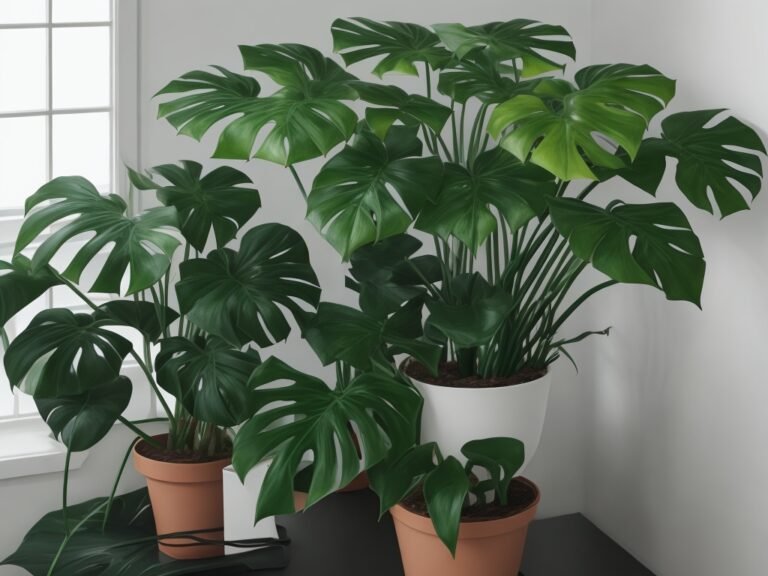How To Get a Monstera To Fruit Indoors?
Key Takeaways:
- Provide adequate humidity and warmth to encourage Monstera fruiting.
- Use a well-draining soil mix and ensure proper watering to stimulate fruit production.
- Provide sufficient filtered sunlight, but avoid direct exposure to harsh afternoon sunlight.
- Patience is key – it may take several years for a Monstera to fruit indoors.
Are you craving the sweet satisfaction of growing your own Monstera fruits right in your living room? Well, you’re in luck! In this article, I’ll share my expert tips on how to make your Monstera plant bear fruit indoors.
From creating the ideal environment to promoting pollination and managing pests, I’ll cover all the essential steps you need to know.
Whether you’re a seasoned plant parent or just starting out, get ready to cultivate a thriving Monstera and enjoy the juicy rewards it has to offer. So, let’s dive in and unlock the secrets to growing delicious Monstera fruits right at home!
| Condition | Actions |
| Light | Place the Monstera in bright, indirect light. Avoid direct sunlight as it can scorch the leaves. |
| Temperature | Maintain a temperature between 65-85°F (18-29°C). Avoid placing it near drafts or in fluctuating temperatures. |
| Humidity | Keep the humidity level high by misting the leaves regularly or using a humidifier. You can also place the pot on a tray filled with wet pebbles. |
| Watering | Water the Monstera when the top inch of soil is dry. Avoid overwatering as it can lead to root rot. Ensure good drainage. |
| Fertilizer | Use a balanced houseplant fertilizer diluted to half strength every month during the growing season (spring and summer). |
| Support | Provide a sturdy support, such as a moss pole or trellis, for the Monstera to climb. This can encourage flowering and fruiting. |
| Patience | It may take several years for a Monstera to fruit indoors. Be patient and continue providing optimal care. |
Understanding the Monstera plant
The Monstera plant, also known as the Swiss cheese plant, is a popular choice among plant enthusiasts for its unique foliage and tropical vibes.
What is a Monstera plant?
A Monstera plant, also known as Swiss cheese plant or Monstera deliciosa, is a popular houseplant with large, glossy leaves that have unique, natural holes.
It is native to tropical regions and is loved for its beautiful foliage.
The Monstera plant is easy to care for and can add a touch of tropical elegance to any indoor space.
Why do people want their Monstera to fruit indoors?
People want their Monstera plants to fruit indoors because it’s a rare and rewarding experience. The fruit, called Monstera deliciosa, is known for its unique appearance and delicious taste.
Many plant enthusiasts enjoy the challenge of caring for their plant until it produces this exotic fruit.
It’s a way to connect with nature and have a sense of accomplishment in their indoor gardening endeavors. Plus, being able to harvest and enjoy homegrown fruit is a truly special experience.

Creating the right environment for fruiting
To get your Monstera to fruit indoors, you need to create the optimal environment for it.
Providing adequate light for fruiting
To provide adequate light for fruiting, place your Monstera plant in a bright location with indirect sunlight. Aim for at least 6-8 hours of bright, filtered light each day.
You can achieve this by placing your plant near a window with sheer curtains or in an area with bright, indirect light.
Avoid direct sunlight as it can scorch the leaves. Additionally, rotate your plant regularly to ensure even growth and exposure to light.
Maintaining the right temperature and humidity levels
Maintaining the right temperature and humidity levels is essential for getting your Monstera to fruit. Aim for temperatures between 65-75°F (18-24°C) during the day and slightly cooler at night.
Keep the humidity levels around 60-70% to mimic the plant’s natural environment.
Use a humidifier or place a tray of water near the plant to increase humidity.

Choosing the right pot and soil for your Monstera
Choosing the right pot and soil for your Monstera is essential for its overall health and growth. Opt for a pot that has drainage holes to prevent waterlogging.
A well-draining potting mix with a mixture of peat moss, perlite, and orchid bark works best.
Avoid heavy soils that retain moisture. Regularly check the soil moisture and adjust watering accordingly.

Proper watering and fertilization
To help your Monstera plant fruit indoors, it’s important to properly water and fertilize it.
Watering your Monstera plant
Water your Monstera plant when the top inch of soil feels dry to the touch.
Ensure that the water reaches all parts of the root system, but avoid overwatering as it can lead to root rot.
Use a well-draining soil and allow any excess water to drain away.
Regularly check the moisture levels and adjust your watering schedule accordingly.

Fertilizing your Monstera plant
Fertilizing your Monstera plant is important for its growth and fruiting.
Use a balanced liquid fertilizer once a month during the growing season.
Dilute the fertilizer according to the instructions on the label.
Avoid over-fertilizing as it can harm the plant.
Always water your Monstera before fertilizing to prevent root burn.
Regular fertilization will keep your Monstera healthy and promote fruiting.
Promoting pollination
To promote pollination in your Monstera plant, focus on understanding the pollination process, encouraging natural pollination indoors, and utilizing hand pollination techniques.
Understanding the pollination process of Monstera plants
Monstera plants have a unique pollination process.
They are insect-pollinated, meaning they rely on insects like bees and flies to transfer pollen from the male flower to the female flower.
The male flower produces pollen, while the female flower receives the pollen and develops into a fruit.
Indoor Monstera plants may need some help with pollination, either by encouraging natural pollination or by using hand pollination techniques.
Encouraging natural pollination indoors
To encourage natural pollination indoors, you can start by understanding the pollination process of Monstera plants.
These plants have both male and female flowers, and pollination occurs when pollen from the male flowers reaches the female flowers.
You can encourage natural pollination by placing your Monstera near an open window or using a small fan to mimic the breeze.
You can also gently tap the flowers to release the pollen.
If natural pollination doesn’t occur, you can also try hand pollination techniques to help your plant fruit.
Hand pollination techniques
Hand pollination is a technique used to ensure pollination and fruiting in Monstera plants indoors. To hand pollinate, you need a small brush or cotton swab.
Gently rub the male flower’s pollen onto the receptive female flower’s stigma.
Repeat this process with multiple flowers to increase the chances of successful pollination.
Managing pests and diseases
Pests and diseases can impact Monstera plants, but there are ways to manage them effectively.
Common pests that can affect Monstera plants
Common pests that can affect Monstera plants include mealybugs, spider mites, and aphids.
These pests can cause damage by feeding on the plant’s leaves and stems, leading to yellowing, wilting, and stunted growth.
Regular inspection and treatment with organic insecticides or neem oil can help control these pests.
Identifying and treating common diseases in Monstera plants
Monstera plants can be susceptible to a few common diseases, but with proper identification and treatment, you can keep your plant healthy. If you notice yellowing leaves, it could be a sign of overwatering.
Adjust your watering routine and make sure the soil is well-drained.
If you see brown spots or black mold on the leaves, it might be a fungal infection. Remove affected leaves and improve air circulation.
Spider mites can also be an issue, causing webbing and speckled leaves.
Treat them with insecticidal soap or neem oil. Regularly inspect your Monstera for any signs of disease and address them promptly to ensure a thriving plant.
Patience and care
To successfully get your Monstera to fruit indoors, it requires your patience and consistent care.
Understanding the fruiting cycle of Monstera plants
Monstera plants typically take several years to reach maturity and start fruiting. The fruiting cycle can vary depending on various factors such as light, temperature, humidity, and care.
Once a Monstera plant is mature enough, it will produce an inflorescence, which is a structure that contains both male and female flowers.
The flowers will eventually develop into fruit, which takes several months to ripen. Patience and proper care are key to encouraging fruiting in Monstera plants.
Providing consistent care and attention to your Monstera
To provide consistent care and attention to your Monstera plant, make sure to water it regularly, keeping the soil moist but not waterlogged. Provide adequate light, preferably bright indirect sunlight.
Maintain a warm and humid environment, avoiding cold drafts.
Fertilize the plant every 4-6 weeks during the growing season. Monitor for pests and diseases and take immediate action if needed.
Be patient and consistent in following these care practices to help your Monstera thrive.
Frequently Asked Questions
How long does it take for a Monstera to fruit?
On average, it takes around 2-3 years for a Monstera plant to mature and start producing fruit.
However, this timeframe can vary depending on various factors such as the plant’s overall health, environment, and care.
Patience is key when waiting for your Monstera to fruit, so sit tight and enjoy the process!
Can you force a Monstera to fruit?
encourage a Monstera plantourage a Monstera plant to fruit, but you cannot force it.
By creating the right environment, providing proper care, promoting pollination, and managing pests, you can increase the chances of your Monstera producing fruit.
However, it ultimately depends on the plant’s natural growth cycle and conditions.
Are there any specific Monstera varieties that fruit more readily indoors?
Yes, there are specific Monstera varieties that are known to fruit more readily indoors. Some popular varieties include Monstera deliciosa and Monstera adansonii.
These varieties are commonly cultivated as houseplants and have a higher likelihood of producing fruits indoors under the right conditions.
Keep in mind that fruiting can still take time and may not occur in every plant.
Final Verdict
Getting a Monstera to fruit indoors requires creating the right environment, proper watering and fertilization, promoting pollination, managing pests and diseases, and most importantly, patience and care. By providing adequate light, maintaining the right temperature and humidity levels, choosing the right pot and soil, watering and fertilizing it correctly, encouraging natural pollination or using hand pollination techniques, and managing pests and diseases, you can increase the chances of your Monstera fruiting.
Remember to understand the fruiting cycle of your plant and provide consistent care and attention.
While it may take some time and effort, the joy of seeing your Monstera produce fruit is worth it. So go ahead and start implementing these strategies to enjoy the rewards of your indoor Monstera fruiting journey.






